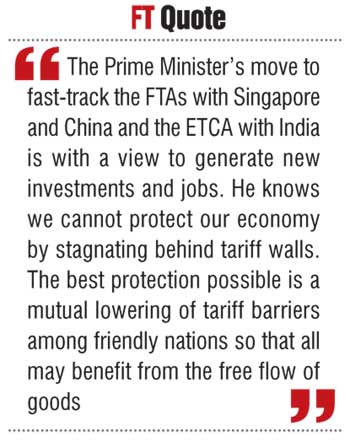A Brief Colonial History Of Ceylon(SriLanka)
Sri Lanka: One Island Two Nations
A Brief Colonial History Of Ceylon(SriLanka)
Sri Lanka: One Island Two Nations
(Full Story)
Search This Blog
Back to 500BC.
==========================
Thiranjala Weerasinghe sj.- One Island Two Nations
?????????????????????????????????????????????????Friday, March 31, 2017
Prime Minister Ranil Wickremesinghe while addressing a press conference last year said that he would not let groups with vested interests create unnecessary problems within the country by spreading rumours and lies about the proposed ECTA with India
Sri Lanka’s debt has increased from Rs. 7.3 trillion to Rs. 9.4 trillion
in the last two years, with domestic rates moving up from 6% to 10.74%.
On a domestic portfolio of Rs. 4,277.8 billion there would be an
additional cost of around Rs. 202.1 billion and for the new borrowings,
the total cost would be Rs. 113.25 billion. An amount of more than Rs.
315 billion would be required to pay back interest. Repayment of the
foreign debt as at 1 January 2015 was Rs. 3132 billion. This has now
moved up to Rs. 4,070 billion. Furthermore, the rate of the US dollar to
the Lankan rupee in January 2015 was 131.00 and by March 2017 the US
dollar to Lankan rupee was around 152.50.
This FX depreciation of around 16% is now having huge implications on all sectors. Furthermore, the downward performances of equity markets, with foreigners exiting both equity and debt securities, has negatively impacted the rupee. We cannot allow interest rates to move up and the Lankan rupee to depreciate any more without a clear strategy.
This FX depreciation of around 16% is now having huge implications on all sectors. Furthermore, the downward performances of equity markets, with foreigners exiting both equity and debt securities, has negatively impacted the rupee. We cannot allow interest rates to move up and the Lankan rupee to depreciate any more without a clear strategy.
Better coordination
 For
a start the Central Bank should ideally come under the purview of the
Finance Ministry like in the past 50 years to ensure both the Treasury
and the Central Bank sing from the same hymn sheet.
For
a start the Central Bank should ideally come under the purview of the
Finance Ministry like in the past 50 years to ensure both the Treasury
and the Central Bank sing from the same hymn sheet.Secondly, to get out of this FX crisis it is best that we start focusing on increasing our export income and tourism income using the 60 plus embassies overseas. The Government has aggressively looked to sign FTAs with China, India and Singapore to boost our export growth and FDIs.
In fact, the Prime Minister, speaking at the World Export Development Forum (WEDF) sessions at the BMICH some time back, said that the Economic Cooperation and Technical Agreement (ETCA) with India that will be signed soon will enable Sri Lanka to have closer engagement with India, especially the five southern states, which together with India are the fastest-growing segment of the Indian subcontinent and at the moment have a combined GDP of $ 500 billion.
He also said that Sri Lanka was negotiating another FTA with Singapore and they were very receptive because they believed that Bay of Bengal countries would be fast-growing countries with fast-growing incomes in the next 20-30 years.
Under the One Belt initiative with China, Sri Lanka is also negotiating a FTA and comprehensive economic partnership dialogue with Japan. The Prime Minister’s move to fast-track the FTAs with Singapore and China and the ETCA with India is with a view to generate new investments and jobs. He knows we cannot protect our economy by stagnating behind tariff walls. The best protection possible is a mutual lowering of tariff barriers among friendly nations so that all may benefit from the free flow of goods.
Increased economic activity resulting from increased trade will provide more job opportunities for our young workers. Our industry, agriculture and services will benefit from increased export opportunities as other nations agree to lower their tariffs. Increased exports and imports will benefit our ports, steamship lines and airlines as they handle an increased amount of trade. Lowering our tariffs will provide an increased flow of goods for our consumers. Our industries will be stimulated by increased export opportunities and by freer competition with the industries of other nations for an even greater effort to develop an efficient, economic and productive system. The results can usher in a dynamic new era of growth unlike in the past where exports dwindled and Sri Lanka had to rely more on remittances and foreign loans.
Growth in exports
Exports are probably part of the answer of where we will find job
growth. However, the issue of exporting our way to job growth is harder
than it appears. When a country exports goods, it sells them to a
foreign market, that is, to consumers, businesses or governments in
another country. Those exports create opportunities and bring foreign
money into the country, which increases the exporting nation’s GDP.
So at a time when good jobs are in short supply, building exports is imperative. But as we boost our exports we will have to start producing more goods that are more labour intensive, that way as exports grow it will become a more productive engine. Therefore job growth isn’t just about where jobs are today; this is where jobs for our young Sri Lankans will be tomorrow.
They need to be job ready. Today the world’s powerful customers and fastest growing markets are beyond our borders. So if we want to find new growth streams, if we want to find new markets and new opportunities, we’ve got to compete for those new customers—because other nations are competing for those customers day and night.
So at a time when good jobs are in short supply, building exports is imperative. But as we boost our exports we will have to start producing more goods that are more labour intensive, that way as exports grow it will become a more productive engine. Therefore job growth isn’t just about where jobs are today; this is where jobs for our young Sri Lankans will be tomorrow.
They need to be job ready. Today the world’s powerful customers and fastest growing markets are beyond our borders. So if we want to find new growth streams, if we want to find new markets and new opportunities, we’ve got to compete for those new customers—because other nations are competing for those customers day and night.
Trade barriers must go
 More
compelling for free trade is the dramatic upturn in GDP growth rates in
India and China after they turned strongly towards dismantling trade
barriers in the early 1990s. In both countries, the decision to reverse
protectionist policies was not the only reform undertaken but it was an
important component. In developed countries, trade liberalisation, which
started earlier in the post-war period, was accompanied by other forms
of economic opportunities, for example a return to currency
convertibility, resulting in rapid GDP growth.
More
compelling for free trade is the dramatic upturn in GDP growth rates in
India and China after they turned strongly towards dismantling trade
barriers in the early 1990s. In both countries, the decision to reverse
protectionist policies was not the only reform undertaken but it was an
important component. In developed countries, trade liberalisation, which
started earlier in the post-war period, was accompanied by other forms
of economic opportunities, for example a return to currency
convertibility, resulting in rapid GDP growth.Moreover, the argument that historical experience supports the case for protectionism is now flawed. The economic historian Douglas Irwin challenged the argument that 19th Century protectionist policy aided the growth of infant industries in the United States. Promoters of free trade should not worry that trade openness results in chaos for some developing countries.
Trade is only a facilitating device. If a country’s infrastructure is bad or has domestic policies that prevent investors from responding to market opportunities such as licensing restrictions, very little progress can be achieved.
Critics of free trade also argue that trade-driven growth benefits only the rich and not the poor. In India for example after economic and education reforms nearly 200 million people have come out of poverty. In China, which grew faster, it is estimated that more than 300 million people have moved above the poverty line since the reforms were initiated. Every major trading nation today is actively negotiating bilateral and regional free trade agreements (FTAs).
However, for free trade agreements to work for Sri Lanka we need to work hard to improve our competitiveness and change the way we run our administration. But we need someone with a backbone in the Government to give leadership to this effort to get ourselves out of this debt crisis. A Cabinet reshuffle is not the answer, good leadership is!

.jpg)


